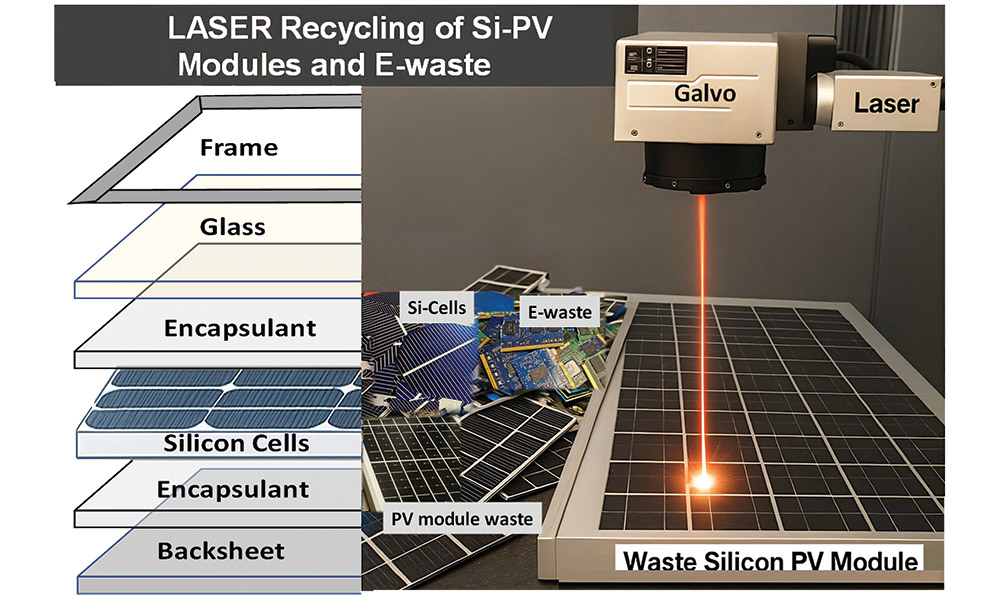
Solar energy has become a viable and affordable source of renewable energy around the world. Solar panels for residential and commercial buildings are more affordable than ever, and they are long-lasting, with a lifespan of about 30 years.
But when solar panels have decreased in efficiency to the point that they need to be replaced, this green solution to energy generation becomes an electronic waste-disposal problem. Most spent solar panels end up in landfills with other e-waste, including personal computers, smart phones, and myriad other electronic devices gone kaput.
By 2050, the world will be grappling with an estimated 78 million tons of solar panel e-waste, says Mool Gupta, a professor of electrical and computer engineering at the University of Virginia, where he is working on a solar-panel recycling solution. Viable recycling solutions for e-waste would meet an important target of United Nations Sustainable Development Goal 12, which emphasizes sustainable patterns of production and consumption to minimize waste, including e-waste, and its impact on the environment and on human health.
Gupta says that dead solar panels can be recycled using chemical and thermal processes, but those processes are not economical. Chemically or thermally decomposing the materials that hold solar panels together requires tremendous amounts of energy and creates safety issues that cost more than the value of recoverable materials. So, landfill disposal has become the default option. Any recycling process proposed for solar panels “has to be cost effective so that people don’t look at the landfill as an option.”
Every year there is a small decrease in the efficiency of a solar module due to polymer films in the solar panel turning yellow from ultraviolet light exposure. When efficiency is reduced by 80%, “then it’s not economic and that’s the end of life. That doesn’t mean the glass is bad and that doesn’t mean the silicon that was used is bad. There are still valuable components that are in good condition,” he says.
Gupta’s approach began with looking at the components of solar panels, which include an aluminum frame, high-quality glass for photovoltaic (PV) application, an encapsulant on both sides of the solar cell, a silicon wafer, and a junction box. He notes that 14% of the world’s silver is used by the PV industry, but other valuable materials include silicon, aluminum, glass, and copper. “If we can recover those components they can be reused,” Gupta says, while also noting that metal recycling reduces the need for destructive minerals mining.
Separating a solar panel’s components with a laser offers the huge advantage of selectivity. To take the panel apart, “You don’t have to heat the whole glass panel,” Gupta says, “you put the energy where you need it.” Similarly, for recovering gold and other metals from electronic devices, “I don’t need to put the energy everywhere, just on the metal I need to recover.”
Gupta notes that laser-material interactions are well understood. “We know how much light is reflected, how much light is absorbed, how much temperature rise it will have, how much melting and ablation will occur…. That science is pretty well understood, so now we’re just going to apply it to this particular [solar-panel recycling] problem.”
The laser also makes it possible to recover silver from solar panels in a high-value nanoparticle form, which has useful applications in medicine. If a sample is immersed in water and then irradiated with a laser, a cavitation in the water vapor is formed, which causes the nucleation and growth of nanoparticles when it collapses. Their value is five to 10 times that of other forms of silver. “A lot of work has been done obtaining [silver] nanoparticles using a laser,” says Gupta. “The same principle applied here is allowing you to get silver and gold or different other nanoparticles.”
In electronic devices, metals are often found in a multilayered structure. First there may be a copper layer followed by a nickel layer, and then by a gold layer in the electronic waste. With a laser, “you can select the power so that you recover only gold, and then you can recover your nickel, and then you can recover copper. And then there are optical techniques, like lase-induced breakdown spectroscopy, where you can measure the light generated during the laser ablation process to monitor what metal you are recovering. That allows you to control the laser parameters, so you don’t contaminate the recovered material.” Gupta says the laser process can yield recovered gold of greater than 90% purity.
Gupta says that a frequent question concerns the recovered glass from a solar cell. The optical transmission is “pretty much the same as the starting glass.” It can be cleaned by the laser and re-used for the PV industry, or it can be used for greenhouses or other applications “rather than just crushing it into powder.” A rough analysis of the economics of glass recovery and cleaning shows that recycling can be favorable, providing a source of preformed material.
Silicon can also be recovered, but Gupta notes that the PV industry uses high-purity silicon, which faces potential supply-chain shortages due to the complex and resource-intensive purification process. Efforts are underway to measure laser-recycling recovered silicon to see how it stacks up.
Gupta stresses the economic value of laser recycling of solar cells, which is achievable at scale given the already widespread use of lasers in other industrial processes. He says that existing recycling companies would be interested in laser-based recycling—a collaborative US National Renewable Energy Laboratory economic analysis is underway—and that new players may want in on the e-waste laser-recycling action.
“The waste is going to increase with time,” Gupta says. “It makes sense for us to look at how do we recycle some of these valuable resources.”
William G. Schulz is Managing Editor of Photonics Focus.